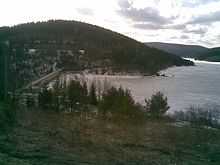Eibenstock Dam
| Eibenstock Dam | |
|---|---|
.jpg) | |
| Location |
Erzgebirgskreis, |
| Coordinates | 50°31′24″N 12°35′21″E / 50.52333°N 12.58917°E |
| Construction began | 1974–1987 |
| Dam and spillways | |
| Impounds | Zwickauer Mulde, Rähmerbach, Geidenbach, Weißbach, Rohrbach |
| Length | 307.5 m |
| Height (foundation) | 65.50 m |
| Height (thalweg) | 57 m |
| Width (crest) | 7.7 m |
| Dam volume | 273,000 m³ |
| Reservoir | |
| Total capacity | 82.9 Mm³ |
| Active capacity | 74.65 Mm³ |
| Catchment area | 200 km² |
| Surface area | 370 ha |
| Normal elevation | 539.60 m |
| Power station | |
| Installed capacity | 1.7 MW |
Eibenstock Dam (German: Talsperre Eibenstock) is the largest dam in the Free State of Saxony in East Germany in terms of the height of the dam above the valley floor and its reservoir is the largest in volume. The dam impounds the waters of the Zwickauer Mulde and supplies drinking water to the region of Chemnitz and Zwickau, as well as providing flood protection, delivering extra water during times of drought and, to a lesser extent, generating electricity from hydropower. Its dimensions make it the second largest drinking water reservoir in Germany's new federal states.
In order to make way for its construction the inhabitants of the villages of Muldenhammer (also called Windischhammer or Windischthal), whose former houses (10 homes, 1 wood sanding shop, 1 large estate for the breeding of Höhenfleckrindern cattle and a paper mill) lie today under the water surface, had to be resettled. Many of them moved to new houses that were built in Eibenstock. In addition the Chemnitz–Aue–Adorf railway between Wolfsgrün and Schönheide Ost was interrupted. The Schönheiderhammer Tunnel on that stretch of the route was flooded. At low water levels the old portals of the tunnel can still be seen. Even the branching line from Eibenstock unt. Bf. to Eibenstock ob. Bf. had to be closed. This section was once known as the Eibenstock Ramp (Steilstrecke Eibenstock) because it was the only standard gauge railway in Saxony that had an incline of 1:20.

The barrier itself is a straight gravity dam made of concrete. The dam was built between 1974 and 1984 near Eibenstock in the Ore Mountains; it was completed in 1987 and taken into service in 1982. The first partial impoundment had been carried out by 1980.
The dam has a pre-dam (Schönheiderhammer Pre-Dam) and four upper basins (Rähmerbach, Geidenbach, Weißbach, Rohrbach).
Above the dam is an observation point from which there is a view of the reservoir. The dam itself is not accessible to the public. Bathing and water sports are also banned, because it is a drinking water reservoir.
See also
- List of dams in Germany
External links
- Eibenstock Dam at www.talsperren.net
- Information on the dam by the Saxon State Reservoir Agency
- Photos of the flooded Schönheiderhammer Tunnel